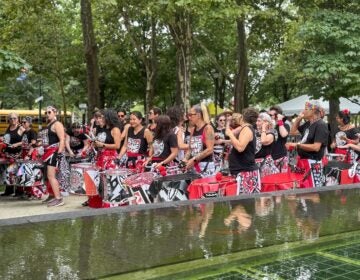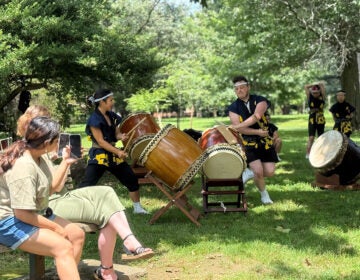Stormwater runoff a problem for Chestnut Hill recreation center
A neighbor of Chestnut Hill’s Water Tower Recreation Center, 209 E. Hartwell Lane, is seeking the Chestnut Hill Community Association’s (CHCA) support in hopes of obtaining a grant from the Philadelphia Water Department to address stormwater runoff conditions at the site.
Robin Spilner, of Ardleigh Street, shared his concerns at CHCA’s Land Use Zoning and Planning committee’s April meeting on Thursday evening. Spilner is proposing that the community work together to apply for funding from PWD as part of its “Green City, Clean Water” plan to protect area watersheds.
A partnership between the CHCA and the city-owned Water Tower could provide “an opportunity to deal with a lot that is a problem, that there isn’t a plan for,” he stated.
A problematic lot
One portion of the Water Tower’s grounds include a triangular parcel bounded by Ardleigh Street, Winston Road and E. Hartwell Lane upon which are six tennis courts. Spilner told LUPZ members that a large paved lot situated next to the courts, at a three foot lower grade, is causing flooding problems for the residents of the 8100 block of Ardleigh Street.
The impervious lot appears to be an afterthought with no defined purpose, he said. It is currently used by skateboarders and as a makeshift dog park.
When it rains, stormwater flows from the courts down a cement slope onto the paved lot on its northwest side. Runoff is also directed to the lot by way of a drainage pipe on the northeast side. Because the lot slopes to the middle, water collects and then runs towards homes on Ardleigh St., which sit at a lower elevation of approximately seven feet. A retaining wall between the homes’ backyards and the Water Tower parcel “acts like a gutter,” channeling runoff to a culvert which connects to storm water drains, Spilner said.
Spilner went on to describe how stormwater runoff has undermined the wall at its foundation, leaving it in a deteriorating condition with crumbling sections. When it rains hard enough, water spills over top the broken parts of the wall. “It’s obvious that thing is not going to last,” he stated. “It can only be fixed so much before it fails.”
Soil is also being pushed aside in areas where there is green space, filling both the culvert and sidewalks on the Winston Road with mud, he explained.
There should have been a retaining pond at the site because of the lot’s lower grade, Spilner noted. Funding for small interventions like tree wells and stormwater planters could give home owners a reprieve from the runoff, he said.
Spilner has already taken the first step in the initial phase of the grant application process, by mapping out impervious surface area and nearby storm water infrastructure on a website he has set up for the project.
Creating a stormwater wetland integrated with a dog park and skate park is the type of long range plan that could “make a dynamic change to that site,” he said.
Where to seek funding
Committee member, John Haak, questioned whether funding should be sought through Philadelphia Parks & Recreation rather than PWD, which may not consider the runoff issue to be significant enough to merit grant money. The Water Tower is a facility which falls under PPR’s jurisdiction. Working through the Water Tower Advisory Council is “a good way to push this forward” to PPR, Haak said.
Chestnut Hill is not part of the city’s combined sewer system, which is high priority for the “Green City, Clean Water” initiative. That may pose an impediment to gaining funding from PWD.
However, CHCA Board member, Tom Cullen, said runoff from property is making its way onto neighborhood streets and its impact on the Wissahickon Creek watershed would be of interest to PWD. “Water is hitting all the storm inlets,” he noted.
The key would be to demonstrate that the lot is causing a runoff problem, remarked committee member, John Landis.
Long range plans
Spilner and committee members agreed that several attempts to do something about lot in the past were not met with success. While a Water Tower Advisory Council exists and is comprised of neighborhood residents, members agreed that more information needs to be learned about the council’s long range planning and whether or not it is actively engaged with PPR.
The tennis courts have not been resurfaced in more than 15 years. Maintenance of courts could be done in concert with addressing the problems of runoff, observed committee member, Jean McCoubrey.
“The Water Tower needs to start paying attention to all of that paved surface,” she asserted.
WHYY is your source for fact-based, in-depth journalism and information. As a nonprofit organization, we rely on financial support from readers like you. Please give today.




